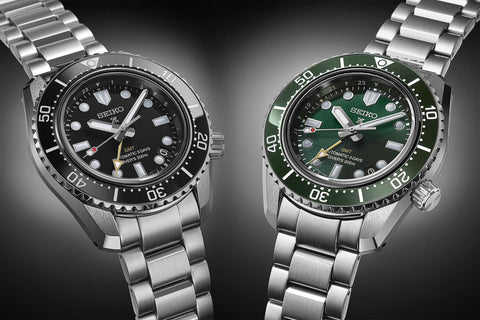The new series features Seiko’s first-ever use of a mechanical GMT movement in a Prospex diver’s watch

As surprising as it might sound, through more than half a century of Seiko Prospex dive watches (the first one dating back to 1965), there’s never been a model with a mechanical GMT movement… Up until today, with the launch of a brand new series of watches. There have been dozens of mechanical dive watches, but the overall concept of the mechanical GMT x Dive watch has remained, for now, the exclusivity of the accessible Seiko 5 Sports Series. It’s time for something more technical and resilient to surface with the new Prospex 1968 Diver’s Modern Re-interpretation GMT SPB381, SPB383 and SPB385.
The association of a GMT function with dive watch capacities has long been one of our favourite typologies of watches. To sum it up, this combination of functions makes a great summer watch ready to dive and travel. Looking at Seiko’s portfolio, very few models have featured this combination. The only interpretation I could find of a Prospex Diver watch with a GMT complication was part of the high-end LX Line and was powered by a Spring Drive movement. Today, Seiko is filling a gap in its ever-growing Prospex range with its first mechanical GMT dive watch powered by a new movement.

The design of this new series of watches is familiar and is based on the brand’s emblematic 1968 dive watch, the reference 6159-7001. First reissued in a high-end, high-frequency watch – the SLA025 – the angular and robust look of this vintage watch has appeared in more regular collections on various occasions ever since. The latest iterations of these Prospex 1968 Diver’s Modern Re-interpretation models are the SLA055 and SLA057, yet again in the higher-end section of the brand’s portfolio. The closest models to the present GMT series are the relatively recent SPB185 and SPB187, sharing identical proportions and in the same price segment. Yet, Seiko has profoundly reworked the concept to make the new GMT Divers unique.

Design-wise, the link with the original 1968 watch is obvious. Solid shoulders, angular shapes, crown at 4 o’clock, wide bezel, strong lines all around the case and alternating polished accents with hairline finishing. According to the brand, the case has been redesigned to have shorter lugs and improved ergonomics, enhancing the comfort on the wrist. Externally, these new references SPB381, SPB383 and SPB385 are clearly diving-oriented models, with a 60-minute scale over a ceramic insert. They feature a screwed crown and caseback, are made of steel with super-hard coating, come with a domed sapphire crystal and are water-resistant to 200 metres. The case measures 42mm in diameter with a 12.9mm height – not thin, but still acceptable.

The dial doesn’t betray the connection with the 1968 model either. The large applied markers and hands, all filled with LumiBrite, use the same design as the vintage model. What’s new is the integration of a central 24-hour GMT hand and a 24-hour scale on the inner flange – a solution that doesn’t afford the best legibility but allows it to retain the 60-minute diving scale. An important note is that these SPB381, SPB383 and SPB385 are office GMT watches since it’s the GMT hand that can be adjusted independently.

Inside the case is the new automatic calibre 6R54, which benefits from a comfortable power reserve, like all 6Rxx series movements. It beats at 3Hz and stores up to 72 hours of energy when fully wound. In addition to the time and GMT, it also displays the date. All three models are worn on a newly designed steel bracelet with super-hard coating, equipped with a folding clasp and a diver’s extension.
Seiko will release three editions of its first mechanical GMT dive watch. First are two watches that will be part of the permanent collection: the SPB381 with a green dial and a green ceramic bezel and the SPB383 with a black dial and a black ceramic bezel. Both have a yellow GMT hand. These will be available from June 2023 and priced at EUR 1,700.

In addition, Seiko is also releasing a new Save the Ocean limited edition, the reference SPB385. This model, which contributes to a greater understanding of the world’s oceans and their preservation, features a rather cool textured ice-blue dial inspired by the polar glaciers that shape the landscapes and seascapes of the Arctic and Antarctic. It features a black ceramic bezel and a dark blue GMT hand. It is worn on the same steel bracelet as the models above, and an additional strap made of recycled plastic bottles using a traditional Japanese braiding technique called Seichu is also included. This version is limited to 4,000 pieces and priced at EUR 1,900.






